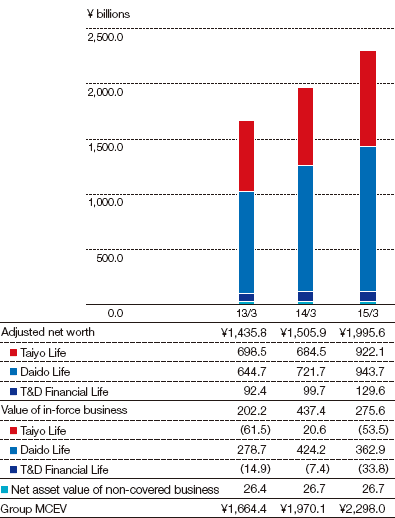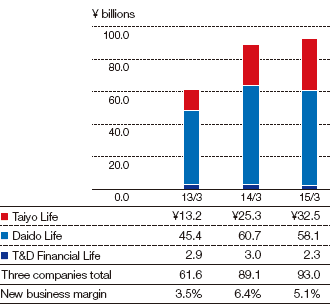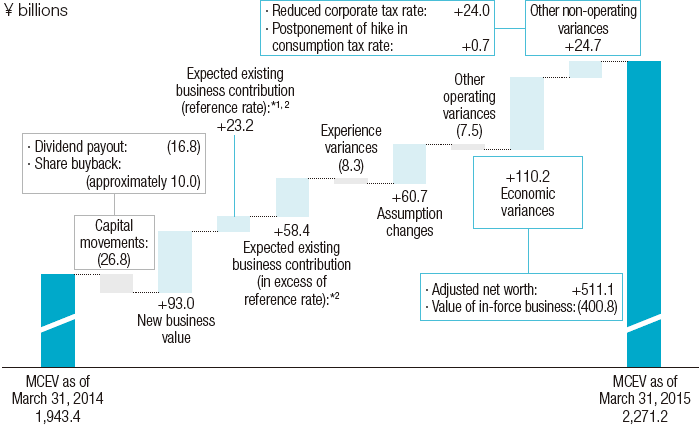The MCEV as of March 31, 2015 was ¥2,271.2 billion, an increase of ¥327.8 billion from the previous fiscal year-end.
The Group MCEV, which is MCEV plus the net asset value of non-covered business, as of March 31, 2015 was ¥2,298.0 billion, an increase of ¥327.8 billion from the previous fiscal year-end.
Group MCEV

Value of New Business
The value of new business increased ¥3.8 billion from the previous fiscal year-end to ¥93.0 billion. The main reason for the increase was the strong sales of Third Sector products primarily at Taiyo Life, despite the negative impact of a decline in domestic interest rates.
Value of New Business

- New business margin = Value of new business / Present value of new business premiums
Movement Analysis
In addition to new business, the Group changed its insurance assumptions such as improvements of the claim incidence rate, and there were economic variances such as increases in the market value of domestic stocks and foreign bonds. As a result, MCEV was up ¥327.8 billion from the end of the previous fiscal year.
Movement Analysis in MCEV from March 31, 2014

- *1 The expected existing business contribution (reference rate) includes the projected amounts of the time value of financial options and guarantees, the cost of non-hedgeable risks, and the frictional cost of capital: ¥9.9 billion, ¥11.8 billion and ¥0.2 billion, respectively.
- *2 The expected return rate was 0.766%, reflecting the risk premiums for each asset class that were used to calculate the amount of expected return.
Sensitivity
The impact of changes in assumptions (sensitivities) on MCEV results is summarized below. For each sensitivity, only one specific assumption is changed and other assumptions remain unchanged from the base. It should be noted that the effect of the change of more than one assumption at a time is likely to be different from the sum of two sensitivities with only one assumption change. Under different sensitivity scenarios, the basis for policy reserves (excluding reserves for separate accounts) is unchanged, in line with the Japanese statutory reserving rules.
Sensitivities
| ¥ billions | |||||||||
| MCEV | Adjusted net worth | Value of in-force business | Value of new business | ||||||
|---|---|---|---|---|---|---|---|---|---|
| MCEV as of March 31, 2015 (base scenario) | ¥2,271.2 | ¥1,995.6 | ¥275.6 | ¥93.0 | |||||
| Economic factor | Interest rate (forward rate; for all future years)*1 | +50bp | 154.1 | (350.1) | 504.2 | 32.6 | |||
| -50bp | (175.1) | 242.4 | (417.6) | (30.9) | |||||
| Equity and real estate value | -10% | (111.8) | (109.5) | (2.2) | - | ||||
| Other factor | Lapse rate | x 0.9 | 86.8 | - | 86.8 | 14.2 | |||
| Operating maintenance expenses | x 0.9 | 50.6 | - | 50.6 | 3.7 | ||||
| Claim incidence rates for the life business | x 0.95 | 96.2 | - | 96.2 | 6.9 | ||||
| Mortality for the annuity business | x 0.95 | (5.2) | - | (5.2) | 0.0 | ||||
| Change the required capital to the statutory minimum | 17.4 | - | 17.4 | 0.6 | |||||
| 25% increase in equity implied volatility | (1.0) | 1.0*2 | (2.0) | (0.0) | |||||
| 25% increase in swaption implied volatility | (35.8) | - | (35.8) | (0.8) | |||||
- *1 Fixed interest assets (bonds loans, etc.) are revalued according to the change in the interest rate. The value of in-force business is re-calculated according to the change of investment yield and risk discount rate. Policyholder behavior also changes corresponding to these changes. If interest rate becomes negative after the deduction of 0.5%, 0% is applied instead.
- *2 The increase of adjusted net worth for equity implied volatility is due to the increase of the market value of put options held by T&D Financial for the purpose of hedging minimum guarantee risk of variable annuities.
